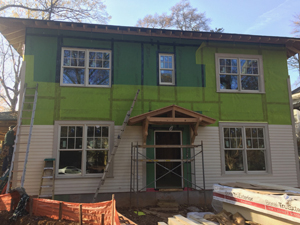May 16, 2017 | Upper Marlboro, MD
Home Innovation Issues First NGBS Green Certification Based on 2015 NGBS
As development of the 2018 version of the National Green Building Standard (NGBS) recently commenced, Home Innovation today issued its first NGBS Green certification of a home to the 2015 version of the standard. The Atlanta-area single-family home of designer and NGBS Green Master Verifier Carl Seville, not only holds the distinction of being the first in the country certified to the 2015 NGBS, but also of being in the elite subset of Emerald-level certified homes.
While a trained and expert designer and verifier himself, Seville’s home was designed by Thomas Hood and verified by Rick Stepp to ensure no conflict of interest in the third-party verification process. But Seville’s expertise with sustainable building, and the NGBS specifically, certainly played a large role in making the home green from bottom to top, inside and out.
The unassuming 2x6 wood-framed home, while beautiful, belies its high-tech “guts.” Below are just some of the cutting-edge green building products and techniques the designer and homeowner incorporated into the home, resulting in its first-of and best-of NGBS Green certification.
WELL-INSULATED ENVELOPE: The home has Owens Corning blown fiberglass insulation in all its interior walls, and Huber Zip R sheathing was used for the continuous rigid foam insulation on the exterior walls. The R-value of the walls is >22, and of the ceiling is 49. The windows are low-E aluminum clad. Entire building was air sealed and reached an ACH50 of .88 (~400 CFM50).
FOUNDATION & EXTERIOR FINISH: Siding and exterior trim is Boral Tru-Exterior, made with coal fly ash and recycled polymers, installed over a Homeslicker vented rainscreen for enhanced moisture protection and durability. A combination vapor and termite barrier by Polyguard was installed on top of the foundation slab, and non-toxic borate termite treatment applied to all wood in contact with the foundation.

EFFICIENT HVAC: Heating and cooling is provided by high-performance Mitsubishi ductless mini splits, with SEER ratings ranging from 19-26. A Broan Energy Recovery Ventilator (ERV) provides fresh air to the house to maintain optimal indoor air quality.
NO-HARM FINISHES: Paints and finishes are all low- or no-VOC, no carpet installed in house to further enhance air quality. Spray foam insulation was only used for minor air sealing to avoid the use of petroleum products and toxic chemicals in the house. A radon vent system provides protection from carcinogenic soil gases. ENERGY STAR bath exhaust fans, by Panasonic, are controlled by humidity sensors to maintain healthy indoor relative humidity.
PRACTICAL INSIDE & OUT: The carport keeps fumes and dirt from cars away from the house, and incorporates a charger for the occupants’ hybrid electric car. A large screened porch provides additional living space that does not require heating and cooling. An open porch at the rear houses a barbeque grill with a Broan range hood to keep the porch area clean and free of grease.
ENERGY SAVINGS: ENERGY STAR-labeled Bosch appliances were installed throughout, including a condensing clothes dryer which has no vent to exterior, thereby avoiding depressurization of home that can lead to degraded air quality and moisture problems. Cooking surface is an electric induction range. All lighting is LED further reducing energy use.
WATER SAVING: All plumbing fixtures are American Standard WaterSense certified. The delivery system is designed to provide hot water to all fixtures within 20 seconds without requiring any pumps. Landscaping includes all native or drought-tolerant species with no turf grass to reduce irrigation and fertilization needs. The home’s driveway is entirely pervious paving to reduce storm runoff and allow rain to filter into the ground more naturally.
WASTE NOT: Over 80% of all construction waste from the project was recycled.
“As an ANSI-approved standard that is required to go through regular public review and consensus-based revision,” said Michael Luzier, President and CEO of Home Innovation Research Labs, “the NGBS will always provide our certification participants the ability to keep pace with the technological and code-based advances that are most appropriate for their market. Regardless of price point or market drivers, NGBS Green certification provides all residential builders the ability to provide their buyers the better-place-to-call-home they’re seeking.”
“Like the two previous versions, the 2015 NGBS (ICC/ASHRAE-700) provides the residential design and construction industry with the single, most-effective way to deliver sustainable, high-performance homes,” according to International Codes Council (ICC) CEO Dominic Sims. “From single-family homes in the suburbs to high-rise apartments in urban areas, the NGBS has become the industry’s green standard.”
For more information on NGBS Green certification, visit our webpage or contact us.
# # #
ABOUT: Home Innovation Research Labs, located in Upper Marlboro, Md., is a full-service research, testing, and consulting firm determined to improve the quality, durability, affordability, and environmental performance of single- and multifamily homes and home building products – in short, we aim to perfect the home. Founded in 1964 as a subsidiary of the National Association of Home Builders (NAHB), our team has been integral in solving many of our client’s most difficult product and technology issues, and helping to introduce some of the most groundbreaking innovations in construction. Through an interdisciplinary research approach – including market research, building science analysis, laboratory testing, and standards development – we help to find a home for innovation in the construction industry.
NOTE TO EDITORS ON STYLE USAGE: To identify this company and its work correctly, first reference should be "Home Innovation Research Labs." In subsequent mentions, “Home Innovation” should be used; we are not identified by an acronym. Prior to February 12, 2013, the company was known as the NAHB Research Center.